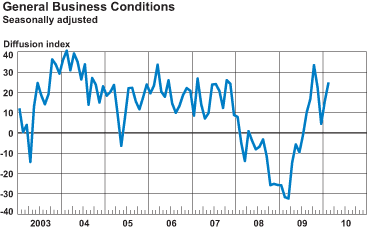February 2010 Report
Survey Indicators
Seasonally Adjusted

The Empire State Manufacturing Survey indicates that conditions for New York manufacturers improved at a healthy pace in February. The general business conditions index climbed 9 points, to 24.9. The new orders index fell, though it remained positive, and the shipments index inched downward as well. The inventories index rose sharply, to 0.0, its highest reading in considerably more than a year. The prices paid index was little changed from its high level last month, and the prices received index remained just above zero for a second consecutive month. Employment indexes were positive for a second consecutive month, although at relatively low levels. Future indexes continued to show a high level of optimism about the six-month outlook.
In a series of supplementary questions, manufacturing firms were asked about recent and expected changes in workforce size and other employment measures (see Supplemental Reports tab). Parallel questions had been asked in January 2009 and April 2008. In the current survey, roughly 64 percent of respondents indicated that they expected their workforce to increase in the year ahead, while just 15 percent predicted declines. This finding contrasts with last year’s survey results, in which respondents expecting increases in the total workforce had outnumbered those expecting declines by just 45 percent to 40 percent. Overall, when asked about the probability of various employment outcomes, respondents were considerably more optimistic than they were last year. The chance that their firm’s employment level would drop 5 percent or more was perceived to be 18 percent, on average, down from 34 percent in last January’s survey.
Business Activity Continues to Pick Up
Business activity improved for a seventh consecutive month in February, and at a relatively rapid pace. The general business conditions index rose 9 points to 24.9, with 42 percent of respondents reporting that conditions had improved over the month, and 17 percent reporting that conditions had worsened. Although the new orders index fell 12 points, it remained positive, at 8.8. The shipments index also fell, from 21.1 to 15.1, while the unfilled orders index held steady at 2.8. The delivery time index retreated to -6.9. The inventories index rose sharply, to 0.0, its highest reading in well over a year, with more than a quarter of respondents reporting rising inventory levels over the month.
Employment Indexes Remain Just above Zero
Both price indexes remained positive. The prices paid index was little changed from last month, holding at a relatively high level of 31.9. The prices received index, which had risen above zero for the first time in more than a year in January, inched up 2 points to 4.2 in February. Employment indexes remained just above zero. The index for number of employees was 5.6, with 21 percent of respondents reporting increased staffing levels and 15 percent reporting reduced levels. The average workweek index advanced 3 points, to 8.3.
Outlook Remains Highly Optimistic
Future indexes suggested that manufacturers in New York State were expecting conditions to improve further in the months ahead. The future general business conditions index was slightly lower than last month, but remained at a relatively high level of 52.8, with 60 percent of respondents expecting conditions to improve over the next six months. The future new orders and shipments indexes held at similar levels. Inventories were expected to be higher in six months – the future inventories index was positive for a fourth consecutive month, rising to 12.5 in February, its highest level in two years. Future prices were expected to continue to climb, as the indexes for both future prices paid and future prices received remained near their recent high levels. Future employment indexes were well above zero, suggesting that employment levels were expected to increase in the months ahead. The capital expenditures index dipped several points, but remained well above zero at 27.8, and the technology spending index held steady at 12.5.










